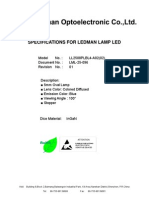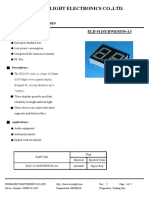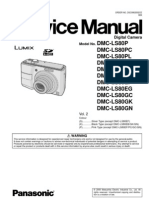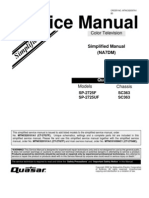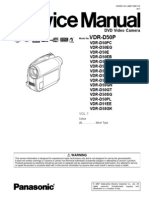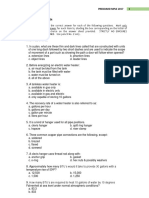Data Sheet For 8mm Super Bright White LED Dip Type 1/2watt High Power LED Series
Data Sheet For 8mm Super Bright White LED Dip Type 1/2watt High Power LED Series
Uploaded by
Etbn SnoaCopyright:
Available Formats
Data Sheet For 8mm Super Bright White LED Dip Type 1/2watt High Power LED Series
Data Sheet For 8mm Super Bright White LED Dip Type 1/2watt High Power LED Series
Uploaded by
Etbn SnoaOriginal Title
Copyright
Available Formats
Share this document
Did you find this document useful?
Is this content inappropriate?
Copyright:
Available Formats
Data Sheet For 8mm Super Bright White LED Dip Type 1/2watt High Power LED Series
Data Sheet For 8mm Super Bright White LED Dip Type 1/2watt High Power LED Series
Uploaded by
Etbn SnoaCopyright:
Available Formats
REFOND INTERNATIONAL OPTOELECTRONIC CO., LTD.
Data Sheet For 8mm Super Bright White LED
Dip Type 1/2Watt High Power LED Series
Features
• General Purpose Leads
• Reliable and Rugged
Absolute Maximum Ratings at Ta=25℃
Parameter MAX. Unit Package Dimensions
Power Dissipation 500 mW
Peak Forward Current* 450 mA
Continuous Forward Current 150 mA
Derating Linear From 50°C 0.4 mA/°C
Reverse Voltage 5 V
Operating Temperature Range -40°C to +70°C
Storage Temperature Range -40°C to +80°C
Lead Soldering Temperature
260°C for 3 Seconds
[ 4mm(.157”) From Body]
* Duty ratio max 1/10 Pulse Width max. 0.1ms;
△ At the position of 4mm from the bottom of the package within 5 seconds.
Electrical Optical Characteristics at Ta=25°C
Dominant Wavelength Viewing
Luminous Intensity Forward Voltage /
λd/ nm Angle
Lens Source Iv / Lm V
Part Number IF = 150mA 2θ1/2 /
color Color IF = 150mA (Note 5) IF = 150mA
(Note8) Deg
Min. Typ. Max. Min. Typ. Max. Min. Typ. Max. (Note 6)
Water
RF-P08A06SWC4-W2 White --- --- --- 8 12 --- --- 3.2 4.0 140°
Clear
Reverse Voltage = 5V Reverse Current = 50µA
Notes:
1. All dimensions are in millimeter.
2. Tolerance of measurement is ±0.25mm(.01”) unless others otherwise noted.
3. Protruded resin under flanges is 1.0mm(0.4”) max.
4. Lead spacing is measured where the leads emerge from the package.
5. Luminous intensity is measured with a light sensor and filter combination that approximates the CIE eye-response curve.
Tolerance of measurement of luminous intensity is ±15%
6. θ1/2 is the off-axis angle at which the luminous intensity is half the axial luminous intensity.
It use many parameters that correspond to the CIE 1931 2°
Tolerance of measurement of angle is ±2.5degree
7. Caution in ESD: Static Electricity and surge damages the LED. lt is recommended to use a wrist band or anti-electrostatic
glove when handling the LED.All devices, equipment and machinery must be properly grounded.
8. High heat energy will be released from the High power LED, Heat sink or alternative heat release method is recommend to
use
9. Specifications are subject to change without notice.
RF-P08A06SWC4-W2 Version 1.0 Page 2 of 3
REFOND INTERNATIONAL OPTOELECTRONIC CO., LTD.
CAUTIONS- Super Bright White LED
1. Lead Forming
a. At least 3mm from the base of the epoxy bulb should be keep when forming leads.
b. Do not use the base of the leadframe as a fulcrum during lead forming.
Lead forming should be done before soldering.
c. Because the stress to the base may damage the characteristics or it may break the LEDs, do not apply any bending stress to the base of the lead
d. When mounting the LEDs onto a PCB, the holes on the circuit board should be exactly aligned with the leads of the LEDs. Stress at the leads should be avoid when the LEDs are mounted on the PCB,
because it causes damage to the epoxy resin and this will degrade the LEDs.
(2) Storage
a. The LEDs should be stored at stored at 30 C or less and 70%RH or less after being shipped and the storage life limits are 3 months.
b. If the LEDs are stored more then 3 months, they can be stored for a year in a sealed container with a nitrogen atmosphere and moisture absorbent material.
c. Please avoid rapid transitions in ambient temperature, especially, in high humidity environments where condensation can occur.
(3) Static Electricity
a. Static electricity or surge voltage damages the LEDs.
b. It is recommended that a wristband or an anti-electrostatic glove be used when handling the LEDs.
c. All devices, equipment and machinery must be properly grounded.
d. It is recommended that measures be taken against surge voltage to the equipment that mounts the LEDs.
e. Damaged LEDs will show some unusual characteristics such as the leak current remarkably increases, the forward voltage becomes lower, or the LEDs do not light at the low current.
Criteria: (VF>2.0V at IF=0.5mA)
(4) Heat Generation
a. Thermal design of the end product was most importance. Please consider the heat generation of the LED when making the system design.
b. The thermal resistance of the circuit board and density of LED placement on the board, as well as other components was the important factor affecting the coefficient of temperature increase per input
electric power. It must be avoid intense heat generation and operate within the maximum ratings given in the specification.
c. The operating current should be decided after considering the ambient maximum temperature of LEDs.
(5) Cleaning
a. It is recommended that isopropyl alcohol be used as a solvent for cleaning the LEDs. When using other solvents, it should be confirmed beforehand whether the solvents will dissolve the resin or not.
Freon solvents should not be used to clean the LEDs because of worldwide regulations.
b. Do not clean the LEDs by the ultrasonic. When it is absolutely necessary, the influence of ultrasonic cleaning on the LEDs depends on factors such as ultrasonic power and the assembled condition.
Before cleaning, a pre-test should be done to confirm whether any damage to the LEDs would occur.
(6) Safety Guideline for Human Eyes
a. In 1993, the International Electric Committee (IEC) issued a standard concerning laser product safety (IEC 825-1).Since then, this standard has been applied for diffused light sources (LEDs) as well as
lasers.In 1998 IEC 60825-1 Edition 1.1 evaluated the magnitude of the light source.
b. In 2001 IC 60825-1 Amendment 2 converted the laser class into 7 classes for end products.
c. Components are excluded from this system. Products which contain visible LEDs are now classified as class 1. Products containing UV LEDs can be classified as class 2 in cases where viewing angles
are narrow, optical manipulation intensifies the light, and/or the energy emitted is high. For these systems it is recommended to avoid long term exposure. It is also recommended to follow the ICE
regulations regarding safety and labeling of products.
(7) Soldering Condition for LED Lamps
a. EPOXY RESIN of LED
Epoxy resin for LED need to be cured within some temperature range with enough time, otherwise it will not hard enough then and moisture in the air will penetrate into epoxy day by day. After some
period later, the epoxy of LED may crack inside and it will reduce the lifetime of the LED lamps. Because of this reason, we REFOND had precisely controlled as in the 2nd Statement.
b. Temperature of Glass (Tg Point)
For ensure the epoxy resin is hard enough, a good process control for epoxy resin ENDCAP process was required, such as precise temperature profile of the over, exactly time for curing and good
selection for epoxy resin. After that we need to measure the Tg point for checking the epoxy resin is hard enough or not. Tg point should be control in range 125-135 centi-grade, if Tg lower than
125degree, it will make the epoxy soft. When soldering higher than 135degree, it will make the epoxy too hard and the epoxy will crack inside easily.
c. For Automatic Soldering
(a) All of soldering equipment needs to check temperature on top of PCB for soldering LED as record.
(b) Pre-heat temperature must below Tg point, otherwise LED will be soft soldering and broken the bonding gold wire inside.
(c) The soldering condition need to below 5 seconds with 260 centi-grade or lower of each soldering point.
(d) The soldering PCB with LED can’t have any vibration or shock after soldering because inside LED epoxy still soft, and this action will cause gold wire broken inside. The best way is to have
cooling fan for cooling down shortly.
d. For Manually soldering
(a) When use hand soldering with extension wire, it is suggested that a fixture for soldering is needed to prevent any strength inside when head is transferring to epoxy through LED leads. Otherwise, it
might have gold wire broken inside.
(b) When use hand soldering with PCB insertion, it must make sure the pitch of OCB for LED leads are the same as LED lead pitch. Otherwise there might have strength transfer to inside epoxy
broken gold wire when soldering.
e. The size of the PCB for automatic soldering
(a) It is very important that PCB will have a little bit bent when soldering, this phenomenon especially for large PCB size. When there are some higher defect rate for LED after soldering, it must
check the PCB size and the PCB is bent or not in this soldering. If this phenomenon happen, the LED leads will be a little bit bent and the gold wire inside may be broken.
(b) It will be good for the LED circuit application if a small size PCB was used.
(c) Then larger size PCB was use; it needs to have special fixture to preventing PCB bending when soldering.
(8) Others
a. Care must be taken to ensure that the reverse voltage will not exceed the absolute maximum rating when using the LEDs with matrix drive. Keeping the Normal Forward to 20 mA.
b. The LEDs described in this brochure are intended to be used for ordinary electronic equipment (such as office equipment, communications equipment, measurement instruments and household
appliances). Consult Refond’s sales staff in advance for information on the applications in which exceptional quality and reliability are required, particularly when the failure or malfunction of the LEDs
may directly jeopardize life or health (such as for airplanes, aerospace, submersible repeaters, nuclear reactor control systems, automobiles, traffic control equipment, life support systems and safety
devices).
IF
Rx
IF = V - VF
VF Rx
V
c. User shall not reverse engineer by disassembling or analysis of the LEDs without having prior written consent from Refond. When defective LEDs are found, the User shall inform Refond directly before
disassembling or analysis.
d. The formal specifications must be exchanged and signed by both parties before large volume purchase begins.
e. The appearance and specifications of thex product may be modified for improvement without notice.
RF-P08A06SWC4-W2 Version 1.0 Page 3 of 3
You might also like
- Audi A6 C6 Air ConditionerDocument260 pagesAudi A6 C6 Air ConditionerВадим Пушкарский100% (4)
- Panasonic+Th 46pz85u+Service+ManualDocument128 pagesPanasonic+Th 46pz85u+Service+Manuala1electronicsNo ratings yet
- Sony Cdx-Gt45uDocument66 pagesSony Cdx-Gt45uVictor Leon Jaime100% (3)
- Aiwa TV Service ManualDocument22 pagesAiwa TV Service ManualSimatar1208100% (1)
- Soldering electronic circuits: Beginner's guideFrom EverandSoldering electronic circuits: Beginner's guideRating: 4.5 out of 5 stars4.5/5 (10)
- A Guide to Electronic Maintenance and RepairsFrom EverandA Guide to Electronic Maintenance and RepairsRating: 4.5 out of 5 stars4.5/5 (7)
- Pioneer Deh-X9600bhs Deh-X9600bt Deh-X9650sd Crt5428Document85 pagesPioneer Deh-X9600bhs Deh-X9600bt Deh-X9650sd Crt5428Merkar ElektronikNo ratings yet
- Product Specification: PLBT3-WDRG2613Document6 pagesProduct Specification: PLBT3-WDRG2613api-62031994No ratings yet
- Luckylight: 0.56" Triple Digit Numeric Displays Technical Data SheetDocument6 pagesLuckylight: 0.56" Triple Digit Numeric Displays Technical Data SheetSergiu BadalutaNo ratings yet
- Property of Lite-On Only FeaturesDocument11 pagesProperty of Lite-On Only FeaturesBLUEE009No ratings yet
- Technical Data Sheet 0.56" Quadruple Digit SMD Displays: ELSF-512SYGWA/S530-E2/S290Document8 pagesTechnical Data Sheet 0.56" Quadruple Digit SMD Displays: ELSF-512SYGWA/S530-E2/S290StuxnetNo ratings yet
- 3.5X3.5 MM SMD Chip Led Lamp: AttentionDocument6 pages3.5X3.5 MM SMD Chip Led Lamp: AttentionAbel GaunaNo ratings yet
- Datasheet LEDDocument4 pagesDatasheet LEDevhyajahNo ratings yet
- 333 2SYGDS530 E2 - DatasheetDocument7 pages333 2SYGDS530 E2 - Datasheetvikas_ojha54706No ratings yet
- DS-0035 3W PM2L-3LLx-SD v1.6Document13 pagesDS-0035 3W PM2L-3LLx-SD v1.6Pavan KumarNo ratings yet
- Specifications For Approval: 395nm UV Led PKGDocument18 pagesSpecifications For Approval: 395nm UV Led PKGStiven AndrewNo ratings yet
- 100W White LEDDocument6 pages100W White LEDLoknathBhartiNo ratings yet
- BrightPhoton - VCSEL - LD0940-B130-0014CC-1035 Spec V.01Document4 pagesBrightPhoton - VCSEL - LD0940-B130-0014CC-1035 Spec V.01黄孙峰No ratings yet
- Luckylight: White Backlight Displays Technical Data SheetDocument6 pagesLuckylight: White Backlight Displays Technical Data SheetanzuresinkNo ratings yet
- Uvtop260 FW To39 LEDDocument5 pagesUvtop260 FW To39 LEDslowmosquitoNo ratings yet
- 5mm Infrared LED IR333/H0: FeaturesDocument8 pages5mm Infrared LED IR333/H0: FeaturesEversonSelbachNo ratings yet
- 3535 White 1W SMD - Specification - R3 - 20160129Document20 pages3535 White 1W SMD - Specification - R3 - 20160129Anonymous G1iPoNOKNo ratings yet
- 3W High Power LED PDFDocument16 pages3W High Power LED PDFtittyjohnNo ratings yet
- 20ka AC SPD Technical ManualDocument6 pages20ka AC SPD Technical ManualKhanh Nguyen DuyNo ratings yet
- LS SF67 (8) 1usd24Document7 pagesLS SF67 (8) 1usd24Nexor PocztaNo ratings yet
- Uvled 385 nv3bDocument5 pagesUvled 385 nv3b林益祥No ratings yet
- Color Television: 27AF46CADocument45 pagesColor Television: 27AF46CASalvador CarreraNo ratings yet
- 5.0 MM Dia Led Lamp 540R2GBC-CC: REV:A / 0Document8 pages5.0 MM Dia Led Lamp 540R2GBC-CC: REV:A / 0Nicholas RichardsonNo ratings yet
- Murata High Performance Electrical Double Layer CapacitorDocument8 pagesMurata High Performance Electrical Double Layer Capacitorkn65238859No ratings yet
- D+led-Ld5rDocument6 pagesD+led-Ld5rJulia EchazarretaNo ratings yet
- Specification: Specification of Electrical Double Layer CapacitorDocument16 pagesSpecification: Specification of Electrical Double Layer CapacitorselocaNo ratings yet
- LED Chip LGDocument18 pagesLED Chip LGMinh Khuê Nguyễn ThịNo ratings yet
- Led 5mm yDocument6 pagesLed 5mm yMarcos PainenahuelNo ratings yet
- Panasonic Viera LCD TC-L37S1 TC-L32S1 Chassis LH9 PDFDocument65 pagesPanasonic Viera LCD TC-L37S1 TC-L32S1 Chassis LH9 PDFSara GreerNo ratings yet
- Especificacion Tecnica LEDDocument10 pagesEspecificacion Tecnica LEDJorge Herrero GarcíaNo ratings yet
- A561E 7 SegmentosDocument5 pagesA561E 7 SegmentosRaulJoseRainieriNo ratings yet
- Display - ELD-511SURWB-S530-A3Document5 pagesDisplay - ELD-511SURWB-S530-A3guibsgvNo ratings yet
- TOTX173: Fiber Optic Transmitting Module For Digital Audio EquipmentDocument5 pagesTOTX173: Fiber Optic Transmitting Module For Digital Audio EquipmentalanNo ratings yet
- Panasonic Tc-L42et60 Chassis La41Document70 pagesPanasonic Tc-L42et60 Chassis La41Anto PurwantoNo ratings yet
- 1.6X0.8Mm SMD Chip Led Lamp: AttentionDocument4 pages1.6X0.8Mm SMD Chip Led Lamp: AttentionTiago SilvaNo ratings yet
- Specification LR770D: SSC CustomerDocument12 pagesSpecification LR770D: SSC CustomerMangesh GaikwadNo ratings yet
- DB0031350ENDocument1 pageDB0031350ENJuan Camilo GomezNo ratings yet
- 1W High Power LEDDocument16 pages1W High Power LEDCalvin BurtNo ratings yet
- Samsung NP530U3Document81 pagesSamsung NP530U3danielradu27100% (1)
- am lg 3433uyr t140 - 初稿Document12 pagesam lg 3433uyr t140 - 初稿soundsystems018No ratings yet
- Led VermelhoDocument4 pagesLed Vermelhocaio felipeNo ratings yet
- DMC-LS80P Dmc-Ls80Pc Dmc-Ls80Pl DMC-LS80E Dmc-Ls80Eb Dmc-Ls80Ee Dmc-Ls80Ef Dmc-Ls80Eg Dmc-Ls80Gc Dmc-Ls80Gk Dmc-Ls80GnDocument41 pagesDMC-LS80P Dmc-Ls80Pc Dmc-Ls80Pl DMC-LS80E Dmc-Ls80Eb Dmc-Ls80Ee Dmc-Ls80Ef Dmc-Ls80Eg Dmc-Ls80Gc Dmc-Ls80Gk Dmc-Ls80GnRonal Gutierrez100% (1)
- Mini TOP Views LEDsDocument11 pagesMini TOP Views LEDsRicky CoxNo ratings yet
- APD-SERIESDocument8 pagesAPD-SERIESRegion 51No ratings yet
- TOTX178A: Fiber Optic Transmitting Module For Digital Audio EquipmentDocument6 pagesTOTX178A: Fiber Optic Transmitting Module For Digital Audio EquipmentOscar Arturo Callirgos LozadaNo ratings yet
- Panasonic Quasar SP 2725f Chasis Sc363 (ET)Document20 pagesPanasonic Quasar SP 2725f Chasis Sc363 (ET)fercikeNo ratings yet
- 5.0Mm Infrared Emitting Diode 520E940CDocument4 pages5.0Mm Infrared Emitting Diode 520E940CRonald TucumanNo ratings yet
- CMRL C Im0337 - 3Document5 pagesCMRL C Im0337 - 3wood_terence7575No ratings yet
- GDTR3RD7 350 PDFDocument2 pagesGDTR3RD7 350 PDFJuscelino SaraivaNo ratings yet
- Panasonic Tc-p42x1 Chassis Gph12duDocument108 pagesPanasonic Tc-p42x1 Chassis Gph12duSergio Cayetano PalaciosNo ratings yet
- Panasonic Tc-42px14 Chassis Gph12du SMDocument108 pagesPanasonic Tc-42px14 Chassis Gph12du SMraulrosiqueNo ratings yet
- Dps CC - Sg110cx DC SPDDocument8 pagesDps CC - Sg110cx DC SPDMauricio ChinarelliNo ratings yet
- VDR-D50 Service ManualDocument56 pagesVDR-D50 Service ManualgondifNo ratings yet
- panasonicSA AK52Document80 pagespanasonicSA AK52Raymon SinghNo ratings yet
- Analog Dialogue Volume 46, Number 1: Analog Dialogue, #5From EverandAnalog Dialogue Volume 46, Number 1: Analog Dialogue, #5Rating: 5 out of 5 stars5/5 (1)
- On-Chip Electro-Static Discharge (ESD) Protection for Radio-Frequency Integrated CircuitsFrom EverandOn-Chip Electro-Static Discharge (ESD) Protection for Radio-Frequency Integrated CircuitsNo ratings yet
- Defect CodeDocument4 pagesDefect CodeJoeIsmailNo ratings yet
- Soldering Welding GluingDocument114 pagesSoldering Welding Gluingyepewi9989No ratings yet
- 21 11 2022 Oakter - Line 04Document1 page21 11 2022 Oakter - Line 04ADitya DevNo ratings yet
- LG 26ld350 Service ManualDocument46 pagesLG 26ld350 Service ManualpablotrifasNo ratings yet
- Preboard 04 Practical Problem 1Document40 pagesPreboard 04 Practical Problem 1Christine Joyce RoseteNo ratings yet
- Elite Nixie': Assembly Instructions and User GuideDocument44 pagesElite Nixie': Assembly Instructions and User GuideWasawat JoongjaiNo ratings yet
- Pioneer X-HM81K (XC-HM81) PDFDocument110 pagesPioneer X-HM81K (XC-HM81) PDFboroda2410100% (1)
- LCD TV: Service ManualDocument31 pagesLCD TV: Service ManualJenica RadulescuNo ratings yet
- A2023-4Document10 pagesA2023-4Karlson Peter GuillenaNo ratings yet
- Stanyl Aplicacoes Gerais - DSMDocument40 pagesStanyl Aplicacoes Gerais - DSMRodrigo GhiroNo ratings yet
- Sharp Lc-60-70le650u 70le657u 70757u C6500u Le755u Le857u C7500uDocument136 pagesSharp Lc-60-70le650u 70le657u 70757u C6500u Le755u Le857u C7500uJuan Carlos Srafan100% (1)
- DSC-W100 para DesarmeDocument8 pagesDSC-W100 para Desarmecarloncho2012No ratings yet
- Deh 5250SDDocument80 pagesDeh 5250SDAnderson Azevedo MarquesNo ratings yet
- Service Manual: DSC-U30Document58 pagesService Manual: DSC-U30Anonymous Lfgk6vygNo ratings yet
- TV LG Led 50ln5710 Chassis La33bDocument120 pagesTV LG Led 50ln5710 Chassis La33bfrake50100% (1)
- L12M3.1++PFL3508 3518 4508 5508 7008 8008 PDFDocument128 pagesL12M3.1++PFL3508 3518 4508 5508 7008 8008 PDFRofo201567% (3)
- Price List - Physics Lab EquipmentDocument4 pagesPrice List - Physics Lab EquipmentJatin Pahuja100% (1)
- LC-60-70LE660U (Main Unit Edition)Document72 pagesLC-60-70LE660U (Main Unit Edition)Alejandro Alcubierre0% (1)
- Soldering Iron - WikipediaDocument5 pagesSoldering Iron - Wikipediafundi.pas2020No ratings yet
- ME 2201 MT 1 Short AnswersDocument40 pagesME 2201 MT 1 Short AnswersgurunathramNo ratings yet
- 32PFL5007 - l12m1.1l - LaDocument87 pages32PFL5007 - l12m1.1l - LaWall Bryson100% (1)
- Color Monitor: Service ManualDocument14 pagesColor Monitor: Service ManualAnonymous Ek100RdbcHNo ratings yet
- 6RA7018 6DS22 0 SiemensDocument736 pages6RA7018 6DS22 0 Siemensduccuong2004No ratings yet
- Soldering 101 - Oxidation, Flux and Fire Scale PreventionDocument12 pagesSoldering 101 - Oxidation, Flux and Fire Scale PreventionEdu2k7No ratings yet
- MI L"STD-1595A 26 February 1982 Superseding MIL-STD-1 595 26 July 1977Document72 pagesMI L"STD-1595A 26 February 1982 Superseding MIL-STD-1 595 26 July 1977Jay MillerNo ratings yet
- Experiment No. 1: Introduction To Metal Joining Process 1. WeldingDocument4 pagesExperiment No. 1: Introduction To Metal Joining Process 1. Weldingprasoon pathakNo ratings yet


































